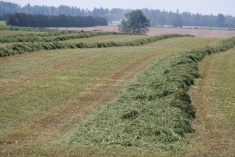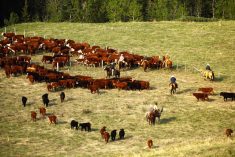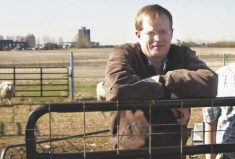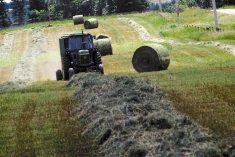This year is going to be a challenge deciding when to bale hay, says provincial beef and forage specialist Barry Yaremcio.
“With yield differences in a field, areas with a low yield will be dry and ready to bale while areas of that field with higher yield potential may need more time to dry and cure before baling,” said Yaremcio. “Baling too soon could result in mouldy, heated feed that is lower in quality compared to what is in the windrow.”
- Read more: Prairie hay crops look thin in many areas
Read Also

Thunderstorms and straight-line winds
Weather columnist Daniel Bezte discusses the strength of straight-line winds during a thunderstorm and the damage they can cause.
With hot weather, baling hay during the day can result in high leaf loss especially, if there are significant amounts of legume in the stand.
“Leaves and flowers are the highest-quality components of a plant,” said Yaremcio. “If there are significant amounts of fine material behind the baler where the bale is dropped, or a lot of leaves are visible on the ground where the windrow was, it might be beneficial to bale the hay at night when temperatures are lower.
“Baling from midnight to 8 a.m. may reduce leaf loss and improve the overall quality of the hay. It can also increase overall yield because more leaves are retained in the bale.”
Moisture content is critical when storing bales, he said.
“The large round bales should have 15 to 16 per cent moisture while the large squares should be down to 12 per cent.”
When it is hotter than normal, the hay temperature in the swath is higher, and the heat is retained in the bale. It provides a great environment for microbial growth, which leads to spoilage. For every 10 C increase in temperature, bacterial growth rates double.
“Thus with higher temperatures, safe moisture levels for baling decrease because of the retained heat in the bale,” said Yaremcio. “The bales will go through a sweat for three to four days after baling, which also causes an increase in bale temperatures. Leave the bales out in the field for a couple of weeks so that the evening and overnight winds can cool the bales and reduce the risk of spoilage.”
While hay may look and smell fine, it needs to be physically evaluated to determine if it is cured.
“Take a small sheath of hay — one-half to three-quarter inch (one to two centimetres) in diameter — out of the middle of the swath and try to break it, just like breaking spaghetti into a pot. If it breaks after bending the stalks, and you can hear it snap and crackle, the plants are cured.
“The second physical test is to take a sheath of hay and hold it in both hands – as done in the breaking test. With hands three to four inches (seven to 10 centimetres) apart, rotate the hands in the same motion as when pedalling a bicycle. If the stems break and it is possible to separate your hands after three or four revolutions, the hay is cured and ready to bale.”
While moisture probes work reasonably well with cured hay, a false moisture reading is possible when used on uncured hay.
“The meters measure the electrical current from one side of the tip to the other. Moisture content in the hay is calculated using equations that are contained in the unit. The amount of current is directly related to moisture present on the outside of the stems and leaves. Moisture content in the centre of the stem could be significantly higher than what is found on the leaves and outside of the stem.”
The use of an inoculant can reduce the wait time before baling.
“Adding inoculant to the hay windrow where yields are heavier, and usually with higher moisture content, allows hay to be baled when moisture content is two to three per cent higher than recommended,” said Yaremcio. “Each product is different so following label instructions is required.”















